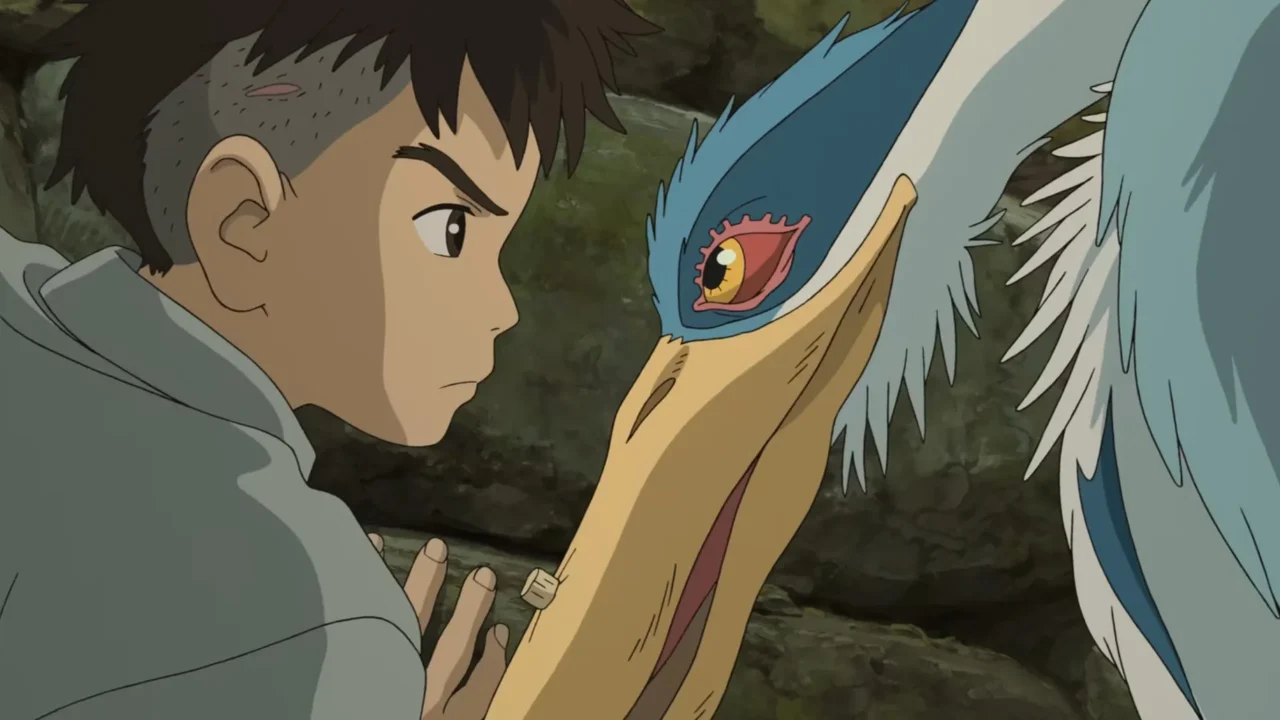Animal Spirit Anime
Hayao Miyazaki’s latest feature is a wondrous feat of storytelling. Mahito and the Heron in The Boy and the Heron. Image courtesy of Studio Ghibli
Mahito and the Heron in The Boy and the Heron. Image courtesy of Studio Ghibli
In the wee hours during a time of war, firebombs strafe an urban hospital. The incendiaries and accompanying sirens compel a preteen to spring out of bed and race towards the flaming building, hoping to rescue his mother.
The Boy and the Heron, Hayao Miyazaki’s remarkable anime fable, simultaneously evokes the young protagonist of Empire of the Sun and the real-life youths of Gaza and Israel. How does anyone, child or adult, endure the grief of loss and the disruptions of war?
Miyazaki, 82, is a gifted artist and visual storyteller whose enchantments, like those of the most beloved fairy tales, actively engage themes of separation, loss and death. He doesn’t make action movies about conquering enemies. He makes contemplative anime about conquering personal fears.
The film opens in 1943 Tokyo as Mahito, the boy of the title, grapples with his mother’s death. The following year, Mahito’s father moves their family of two to the countryside. There Mahito learns that he is about to become part of a family of four.
For Mahito’s father, the proximity to his aviation factory and new spouse (his late wife’s younger sister, who is pregnant) is for the better. But for Mahito, shell-shocked and motherless, the move threatens to be for the worse. The new house bustles with nosy grandmas who fuss over the newcomer (think of the seven dwarfs, but geriatric). His father enrolls him at a school where his fellow students bully him. Enter Mahito’s spirit guide, a heron that very well might be a human in a bird suit. At this juncture, Miyazaki’s shimmering, hand-drawn images and contexts take over, transporting the viewer with the beauty and logic of dreams. Miyazaki doesn’t communicate plot. His is a hieroglyphic world of signs and feelings.
His endlessly surprising movies promise something greater than beauty and a happy ending.
A pesky gray heron with blue tail feathers, one of the many winged creatures in this fable—Pelicans! Parakeets! Budgies!—teases and taunts Mahito. His aunt has been kidnapped, but his mom is alive, says the heron, tempting the boy to accompany him to a nearby tower, reportedly the ancestral home of his mother and aunt, with the promises of a mother-and-child reunion.
Inside the stone tower topped by a turret resembling a witch’s hat there are adjacent worlds, and a river runs through them. Miyazaki has an expansive vision of time, and suggests that the past, present and future are part of a continuum where dead, living and unborn can connect and reconnoiter, learning from the past to improve the present and future.
Thus, inside the stone tower Mahito visits the past and meets his mother when she is his age. Mahito might not have been able to save her at the Tokyo hospital, yet inside the tower he can strengthen his bond with her younger self. While there, Mahito glimpses the effects of the present on the future. Should the parakeet army waging war against an unseen enemy prevail, then the adorable white creatures called warawara — presumably the spirits of the unborn — might be collateral damage.
In the highest elevation of the tower, Mahito encounters a white-bearded ancestor, a great-uncle, struggling to balance Jenga-like building blocks while the tower trembles. Is it a sign to Mahito that equilibrium is the key to finding one’s feet?
I am grateful that Miyazaki has not, as previously announced, retired from filmmaking. His endlessly surprising movies promise something greater than beauty and a happy ending. They promise the serenity of a peaceable kingdom.
Your support matters…Independent journalism is under threat and overshadowed by heavily funded mainstream media.
You can help level the playing field. Become a member.
Your tax-deductible contribution keeps us digging beneath the headlines to give you thought-provoking, investigative reporting and analysis that unearths what's really happening- without compromise.
Give today to support our courageous, independent journalists.
You need to be a supporter to comment.
There are currently no responses to this article.
Be the first to respond.